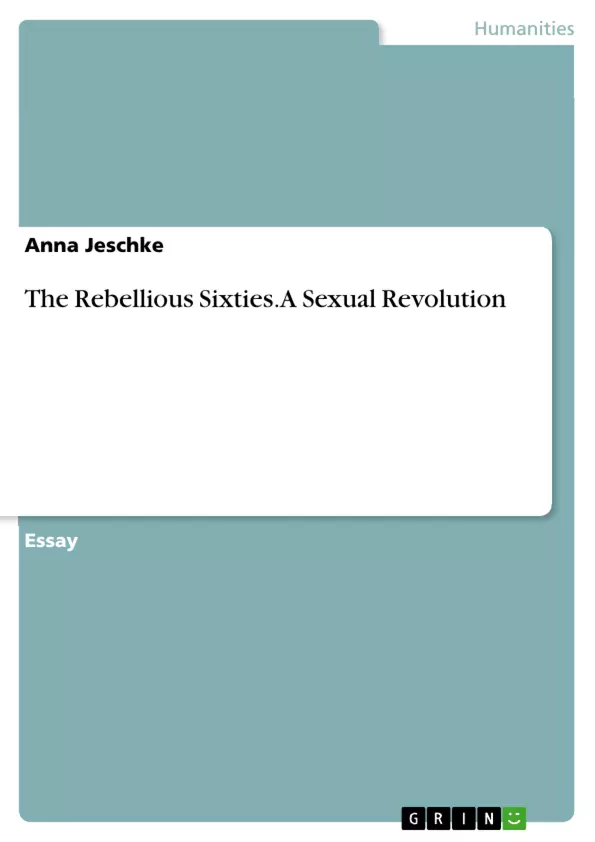This essay discusses the pill's influence on the sixties women movements.
Although conventional contraceptive methods such as the condom or the diaphragm already existed, no product struck as quickly and as successfully as the birth control pill. Within the first three years after the introduction of the pill in 1961, around half a million women were attracted to the contraceptive (Cook 2004). The fact that the prescription of the pill was linked to several conditions makes its success all the more impressive.
Table of Contents
- The Sexual Revolution
Objectives and Key Themes
This text aims to analyze the impact of the birth control pill on the sexual revolution of the 1960s. It argues that the pill was a determining factor in this societal shift.
- The impact of the birth control pill on family planning and women's independence.
- The shift in societal attitudes towards sex and premarital relationships.
- The role of the pill in women's sexual emancipation and autonomy.
- The changing landscape of sexual education and its adaptation to societal changes.
- The relationship between increased sexual activity and the transmission of sexually transmitted diseases.
Chapter Summaries
The Sexual Revolution: This chapter explores the profound impact of the birth control pill on the sexual revolution of the 1960s. Despite initial limitations in access (due to gynaecological resistance and restrictions on unmarried women), the pill's rapid adoption demonstrates its significance. The text contrasts the pill with older contraceptive methods like condoms (made of less pliable rubber) and diaphragms (requiring gynaecological knowledge often unavailable at the time), highlighting the pill's superior effectiveness and ease of use. The chapter argues that the pill's impact extended beyond mere family planning. By enabling women to control their fertility, it facilitated career pursuits and economic independence, contributing to women's emancipation. Moreover, it decoupled sex from its solely procreative function, allowing for the exploration of sexual pleasure outside the confines of marriage. The increased incidence of premarital sex, despite social stigma, is presented as evidence of this shift. The chapter further connects the pill's impact to the broader social and political upheavals of the 1960s, including the rise of feminism and the Free Love movement, asserting that the pill provided the safest and most reliable means to realize the movement's goals of sexual self-determination.
Keywords
Birth control pill, sexual revolution, women's emancipation, family planning, sexual autonomy, premarital sex, sexually transmitted diseases, sex education, 1960s, feminism.
Frequently Asked Questions: The Impact of the Birth Control Pill on the Sexual Revolution
What is the main focus of this text?
This text analyzes the profound impact of the birth control pill on the sexual revolution of the 1960s. It argues that the pill was a pivotal factor in this significant societal shift.
What are the key themes explored in this text?
The key themes include the impact of the birth control pill on family planning and women's independence; the shift in societal attitudes towards sex and premarital relationships; the role of the pill in women's sexual emancipation and autonomy; the changing landscape of sexual education; and the relationship between increased sexual activity and the transmission of sexually transmitted diseases.
What is the significance of the birth control pill according to this text?
The text highlights the pill's superior effectiveness and ease of use compared to earlier methods. It argues that by enabling women to control their fertility, the pill facilitated career pursuits, economic independence, and overall women's emancipation. Furthermore, it decoupled sex from its solely procreative function, allowing for the exploration of sexual pleasure outside marriage. The increased incidence of premarital sex is presented as evidence of this shift.
How does the text connect the birth control pill to broader social and political changes?
The text links the pill's impact to the broader social and political upheavals of the 1960s, including the rise of feminism and the Free Love movement. It suggests that the pill provided a safer and more reliable means to realize these movements' goals of sexual self-determination.
What are some of the challenges related to the adoption of the birth control pill discussed in the text?
The text mentions initial limitations in access to the pill due to gynecological resistance and restrictions on unmarried women.
What are the key differences between the birth control pill and older contraceptive methods?
The text contrasts the pill with older methods like condoms (made of less pliable rubber) and diaphragms (requiring gynecological knowledge often unavailable at the time), highlighting the pill's superior effectiveness and ease of use.
What keywords are associated with this text?
Birth control pill, sexual revolution, women's emancipation, family planning, sexual autonomy, premarital sex, sexually transmitted diseases, sex education, 1960s, feminism.
What chapter summaries are included?
The provided HTML includes a summary of "The Sexual Revolution" chapter, detailing the profound impact of the birth control pill on this period.
- Quote paper
- Anna Jeschke (Author), 2021, The Rebellious Sixties. A Sexual Revolution, Munich, GRIN Verlag, https://www.hausarbeiten.de/document/1239703


